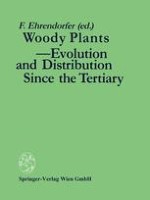1989 | OriginalPaper | Buchkapitel
Development and regional differentiation of the European vegetation during the Tertiary
verfasst von : Dr Dieter H. Mai
Erschienen in: Woody plants — evolution and distribution since the Tertiary
Verlag: Springer Vienna
Enthalten in: Professional Book Archive
Aktivieren Sie unsere intelligente Suche, um passende Fachinhalte oder Patente zu finden.
Wählen Sie Textabschnitte aus um mit Künstlicher Intelligenz passenden Patente zu finden. powered by
Markieren Sie Textabschnitte, um KI-gestützt weitere passende Inhalte zu finden. powered by
The Tertiary vegetation of Europe evolved from paratropical to warm-temperate and temperate forms in response to a progressive, non-linear, climatic cooling. Its vegetational forms are composed mainly of two separate ecological units: the evergreen, laurophyll “paleotropical geoflora” and the deciduous, broad-leaved “Arctotertiary geoflora”. The development of the Tertiary climate and its interaction with the vegetation are convincingly indicated by the geoflora’s migration; the changes in its composition; and the development of the Tertiary forest, swamp, and aquatic plant communities. The “paleo-tropical geoflora” is characterized in the upper Cretaceous to the upper Miocene by para-tropical rain forest, subtropical rain and laurel forests, temperate laurel forests and edaphically-mediated formation of laurel-conifer forests. The “Arctotertiary geoflora” advanced into Europe in waves since the Paleocene and formed the basis for the Tertiary mixed mesophytic forests. These can be divided into warm-temperate rain forests, oak-hornbeamchestnut or mixed beech-oak-hornbeam forests, and edaphic formations such as bottomland and swamp forests. Beginning in the lower Cretaceous, the hydrophytic vegetation developed independently of the forest vegetation and formed very diverse herbaceous fresh water, swamp, salt water, and coastal formations. Considerable differences in composition allow to separate floral regions and provinces in Eurosiberia. Instead of three ill-defined floral regions in the Paleocene, there are four well-defined floral regions in the Pliocene. A Mediterranean region cannot be recognized, although Mediterranean (eumesogeic) floral elements appear in the Eocene/Oligocene and thereafter. The Mediterranean sclerophyll forests probably arose after the destruction of the laurophyll forests during the Pleistocene.
